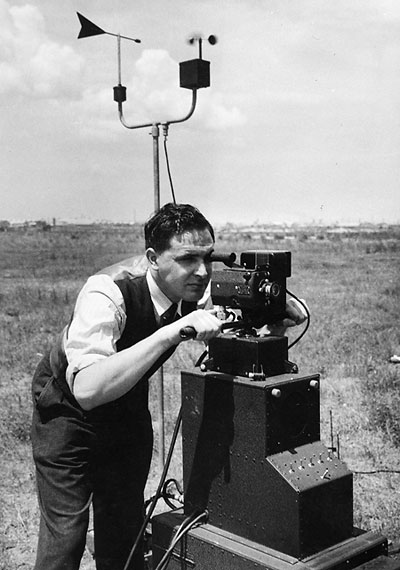
In the 1940s and early 1950s the measurement of takeoff and landing
performance for aircraft was still something of a novelty. Many
accidents were, however, being caused by pilots misjudging their aircraft's
performance and so Civil Aviation authorities around the world began
to take an interest in the more precise definition of aircraft performance
as part of the type certification process.
The Australian DCA was at the forefront of defining the performance of civil aircraft and, in fact, produced Flight Manuals for Australian-registered light aircraft up until the 1990s. DCA was also concerned with the measurement of performance of airline aircraft from a point of view of both improving operational safety and such other areas as airport planning.
In order to produce the required data economically, DCA engineers devised the Operational Research Camera, seen in the photo above at the Commonwealth Aircraft Corporation and Government Aircraft Factory's Melbourne/Fisherman's Bend aerodrome, c.1950 (click here to see another photo).
The design and use of the Operational Research Camera was explained in an article in the June 1950 issue of the Civil Aviation Journal:
Photographic methods for measuring aircraft performance are liable to error and expensive to operate and maintain. The Department, faced with the necessity of using such methods, had to devise an inexpensive but accurate camera to record aircraft takeoff and landing performance.
The equipment was designed to record statistically basic aircraft performance and all significant variables and atmospheric conditions at the time of observation. In addition it would determine position error corrections using the fly-past method. From these the computation of normal rates of acceleration and deceleration during take off and landing, together with the normal unstick and touch down speeds could be computed.
The statistical recording of large numbers of take-off and landings is necessary so as to give proper and accurate emphasis to variations in pilot technique when devising performance standards for these two most important flight operations. I.C.A.O. realizes the importance of having statistics on a large scale when devising airworthiness standards and member States have been requested to obtain such statistical records with details of significant variables.
The equipment consists of a sighting head fitted with a 16 mm cine-camera free to rotate in azimuth and elevation and whose motion is transmitted by an autosyn transmitter to a compass repeater on an instrument panel. A second 16 mm cine-camera, synchronized with the first, photographs the instrument panel which records the track of the sighting head, wind speed and direction, time on a stop watch, air pressure and air temperature. The wind speed and direction finder is a separate unit consisting of an arm bearing an anemometer and director vane, each operating an autosyn transmitter which records on a dual compass repeater on the instrument panel. The arm is supported on a pole 6 feet above ground level and is placed about 20 feet from the observer.
An interesting feature is the fitting of a command radio receiver to enable the camera operator to receive the "ready" signal as the aircraft to be observed reports to the control tower or to the operator direct.
Power for the complete unit is supplied by two 12-volt heavy duty accumulators which, with continuous operation, can be expected to give full power for 1 hour. However, when the unit is operated intermittently for statistical observations, a period of operation of up to 8 hours can be obtained.
In operation the unit is set up about 200 yards from the runway. This distance varies with the runway length required to be covered by the camera, and it is estimated that the maximum usable field of a single camera is 2500 linear feet of runway length.

Left: The Operational Research Camera being used to measure the performance of Australian National Airways' Douglas DC-4 VH-ANE Arkana.
Below: A typical frame from an Operational Research Camera film - this one showing ANA Bristol 170 Mk 21E Freighter VH-INJ Pokana.
The Operational Research Camera resides today in the Airways Museum collection.

(Photos:
Top-Sun News-Pictorial/CAHS collection / Middle-CAHS collection / Bottom-Maurice Austin collection)
Back to the main Airworthiness index
If this page appears without a menu bar at top and left, click here